
|   |

|   |
|
February 2024 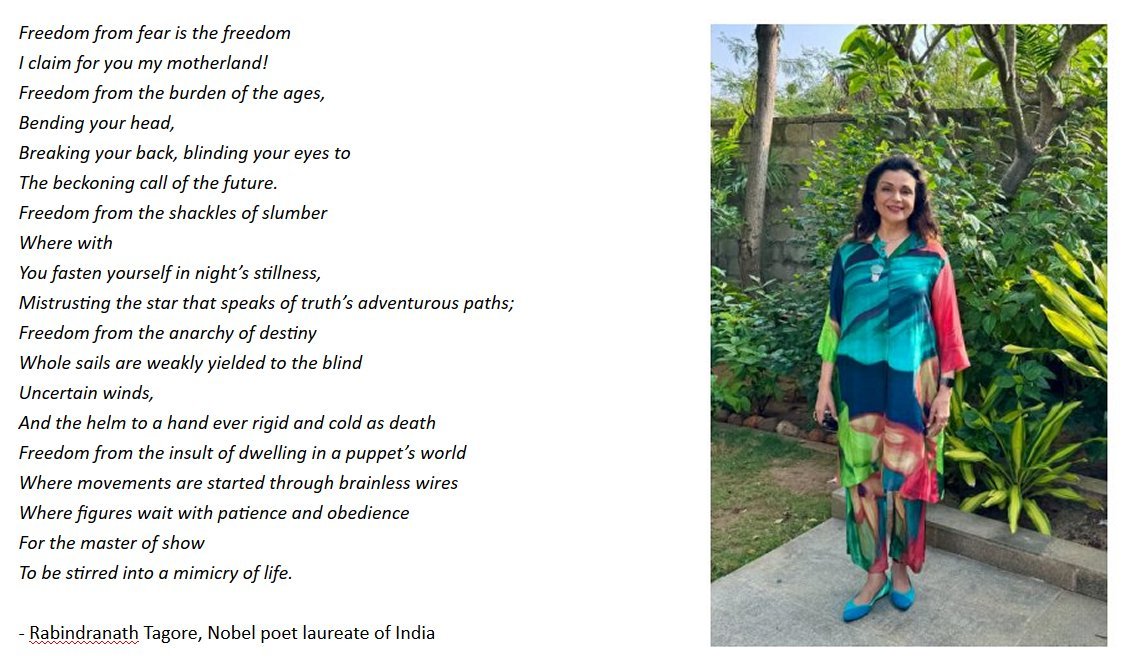 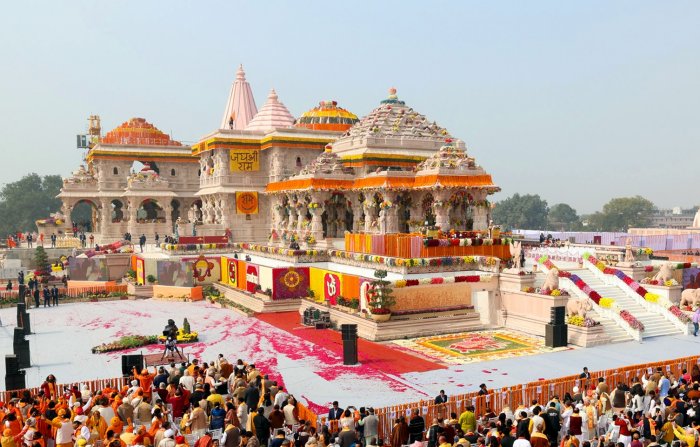 Ram Mandir, Ayodhya Courtesy: Ram Mandir, Wikipedia How can I begin this month's musings without mentioning January 22nd and the inauguration of the Lord Rama temple in Ayodhya, Uttar Pradesh. Nobody, anywhere in the world it seemed, could escape this extravagant show. My WhatsApp was flooded with texts and questions about "What is happening in India?" World media was full of India's "dangerous tilt" towards autocracy. Diaspora Indians were seen celebrating in many cities across the planet. Opinions were sharply divided but the overwhelming majority made their feelings clear - from Ayodhya to Silicon Valley, on the streets of MALDIVES and onto the Times Square marquees in New York City. One thing is clear. The needle has shifted. Politics and religion have come together in a potent mix that will impact the future of young India. What will happen is to be awaited. As celebrities herald the return of RAM RAJYA, we could practice some silence and contemplation instead of ringing the death knell or the celebratory bell. Everywhere in India, especially the North and the East, the joy is palpable and long lines with record crowds are surging towards the birth place of Lord Rama. Politics has also entered into the realm of art and art making. There is a circular for a popular national theatre festival that has been sent to many artistes about WHAT KIND OF DANCE-THEATRE ART they should be making. What the criteria and what the tone and emotion of the entire creative endeavour should be! This is certainly a moment of concern but there it is! In writing- plain as day! Many classical dancers seized the moment of the lead up to the temple consecration to pose in the famous bow-holding pose of Lord Rama on their Instagram handles. Musicians posted reels of themselves singing songs in praise of the Prince of Ayodhya. While many academics and some contemporary artistes were cynical and openly critical at the lavish display via the media, it was evident that the epic of Rama and Sita is back firmly on centre stage and will occupy conversations and generate more spin offs via TV serials and books in the coming months. AI has already intervened, with the child like black idol of RAM LALLA breaking into a smile and a wink! Speaking about Artificial Intelligence - AI is here! The media calls this technology "disruptive". We are going to see more and more AI interventions in music, dance, visual arts and much more. How are we going to acknowledge and accept it? How flexible can we be with this totally alien presence in our lives that can replicate our voices and movements? Sitarist Anoushka Shankar says that AI cannot replace true creativity but then the larger public will not be able to discern reality from technology! Watch out! More on that subject in the coming months. # THE REPUBLIC AT 75 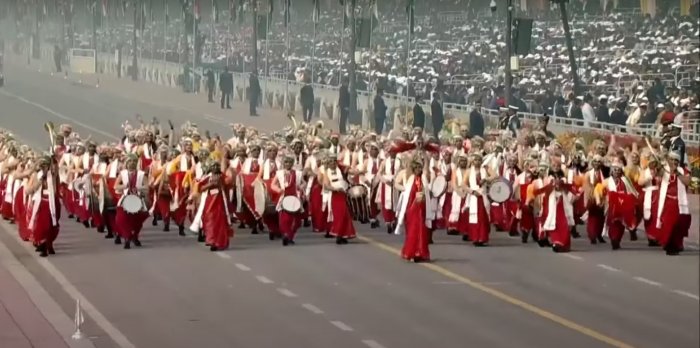 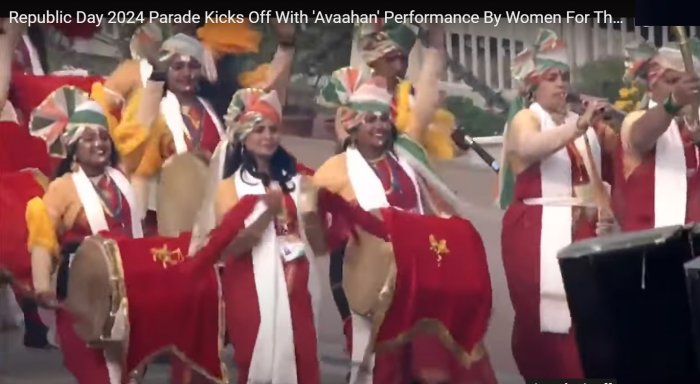 Avaahan 112 musicians - all women - led the 75th Republic Day Parade down Kartavya Path in New Delhi in the freezing cold of January 26. The event, titled AVAAHAN, featured traditional instruments like the Shanku (conch), Nagaswaram, dhol, nagada, dappu and tasha among several others. It has taken 75 years of the Republic to arrive at this point of showcasing its women percussionists. It was truly a rousing and exhilarating spectacle in the freezing cold of New Delhi. Throughout January, the dance season in Chennai (that refused to conclude!) was drenched with an overdose of Bharatanatyam. I attended more shows than I have done in the past 5 years. In addition to presenting artistes in my personal studio space, I got the opportunity to watch established and emerging performers. I will focus my observations on what I have observed during the month of January. #PURUSH IN THE LIMELIGHT 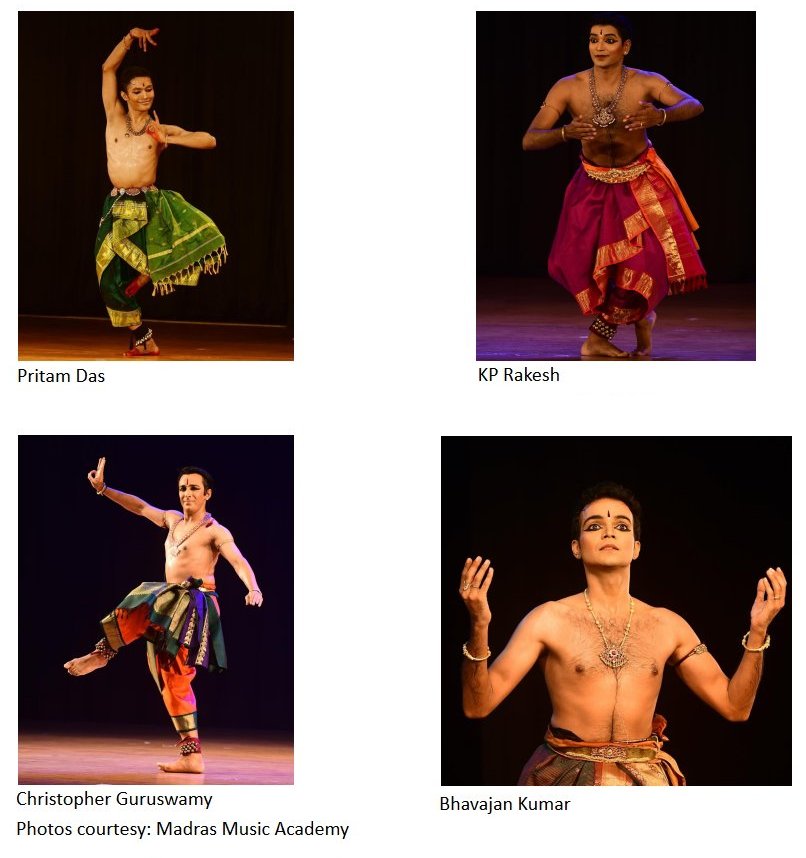 It was a clear triumph for male dancers. Again and again they succeeded in bringing audiences to their feet in admiration and applause. It cemented the arrival of a whole new energy for Bharatanatyam. Energetic, dynamic and pleasing; embracing their identities and bringing a compelling physicality to the limelight, G Narendra, Christopher Guruswamy, Kali Veerapathiran, Pritam Das, KP Rakesh, Bhavajan Kumar, Parshwanath Upadhye were just some of the dancers for whom large crowds showed up with enthusiasm and left smiling. A. Lakshmanswamy, also featured this season, stands apart as a senior dancer-guru, who has trained several stars and whose occasional performances still glisten in the original Vazhuvoor style of his guru KJ Sarasa. Now, let the repertoire shift and change for these wonderful artistes. Can new compositions be created for them so that these male dancers don't always have to play the feminine "Nayika" in a permanent state of longing? Some are convincing and others are merely cloying. New energy needs new content. Exciting times indeed! #TIGHTENING THE CURATION BELT The Music Academy, Chennai, has cemented its place as the most important venue for classical dance in the Chennai cultural calendar. It has surpassed the spot that was once occupied by Krishna Gana Sabha in the 1980s and 1990s. For a cultural organisation that is flush with funds and donors standing in line to enrich their coffers with more endowments, it is high time that the Academy's dance committee paid more attention to appointing an Artistic Director for the December dance festival. The communication channels between the MA and selected dancers mandates that each performer submit their list of items as early as August of the year. So then, why was the audience assaulted with 8 MOHAMANA varnams? I use this word deliberately since there were as many as 3 performers who danced MOHAMANA on the very same day! Did the organisers not notice the repetition? Could they have not alerted some of the dancers who submitted their list later than others that they would have to change their varnam? Even the VARNAM SALON in NYC checks with all the artistes about the varnam of their choice so as to not repeat the same composition! If the selected dancers had submitted one varnam in their list and danced another at the festival, should not the artistes be put aside for a cooling period of 3 years for flouting rules? Bharatanatyam's aesthetics and content are changing rapidly. The January dance festival does not reflect this diversity. In the name of "exploring tradition", audiences witnessed some artistes wandering around the stage as if they had forgotten to turn on Google maps because the Divine lover did not send His lady love the location pin! The Alarippu, Jatiswaram or a Sabdam have almost disappeared from the dancer's repertoire. What then is the TRADITION that the organisers are speaking about? What are they holding on to with such ferocity? Today's generation of dancers is quick, smart, capable, tech savvy, attention deprived and impatient. Their own creative antennae should be set alight. Revered cultural symbols like the Music Academy should recognise this and find a way of balancing the changing currents while creating a historical reference point for the audience. For the more than 2000 performances recorded this season, the fatigue showed on the singers and writers. I watched some of the vocalists, who had accepted 3 shows a day, falter and hesitate at important moments. Failing to pick up the lyric when the 'jati' ended and searching for their cues on their iPads. Given that each dancer gets not more than 2 rehearsals with the entire orchestra, it is a wonder that they are able to get on stage at all! With the density of shows and paucity of accompanists, dancers often end up agreeing to perform to the songs that the singer already knows. Overall, the standard of dance music has declined. I do not see the freshness and enthusiasm that Sudha Raghuraman brings to her every performance. I listened to veteran Radha Badri who has become very choosy with her appearances, as well as Nandini Anand who is careful about over exposure. Murali Parthasarathy, a favourite of senior dancers, sounded tired although his interpretations are always pleasing to hear. Several younger singers were not careful about pronunciation of Sanskrit, Marathi, Hindi and Tamil lyrics and the result was far from pleasing. Crowds for classical dance during the season are not increasing. With so many alternate choices of "entertainment", it is going to be increasingly challenging to convince coming generations to choose an evening of dance when given the choice of a good film, standup comedy, musical variety show - all accompanied by food and drink. Audience development is not being paid attention to. Advocacy for dance needs to be stepped up - quickly. One visitor to the city observed that Chennai is not a naturally art loving city any more. "They come for the artiste not the art". While personality cults abound in other genres, it was disappointing to see the lack of enthusiasm for well-staged shows like SAMAGATI by NATYA VRIKSHA and people walking out during the NRITYAGRAM presentation. Ensemble work is the call of the hour by every funder and presenter. This is a special skill that needs to be acquired by so many choreographers. Watching is one way of learning. #DANCING WORDS Exhaustion was everywhere. Not just with the dance musicians, but even among the writers and reporters covering the season. THE HINDU and this portal are the two main publications that give attention and space to the dance festival. NARTHAKI focuses on dance with some allied and intersecting topics. THE HINDU is besieged (that is the accurate term) with so many articles and requests for coverage from dancers and musicians that the season coverage extends all the way to the end of February or even early March. NARTHAKI's digital space allows for a quicker turnaround of information but even there we find some unhappy dancers who feel ignored. When writers are assigned or offer to cover some events for us, we suggest that they try to watch as many artistes as possible. But, when the Music Academy has 35 performances in a week, it is not possible for one or even two people to watch all the shows. Even writers are like audiences. They too suffer fatigue. They do not watch every single artiste. When a young performer complains of not being written about, I really want to retort sharply to the entitled attitude. On the flip side I realise - being a performer - of how important a review or a report is towards the growth of any artiste. It is like closing the circle of experience. Dance scholar Urmimala Sarkar pointed out in an earlier event that "dance evaporates after the show but the writing of the performance keeps it alive." But not everyone or everything can be included. While curating 5 dance conferences and festivals, our organisation hired two independent writers to cover all aspects of the event, not waiting for the mainstream media to act. This way, we had a document and a report to send to each participating artiste. The main sabhas can easily do this for the December season and put it out on their own social media handles. Being alert to these inequities and trying to balance reportage is part of the challenge during the Chennai season. However, this year we have a greater number of reviews and reports on a variety of dance events that occurred. The offbeat and unusual did not get the coverage it deserved. Like LIVES OF CLAY by Vidya Tirunarayanan at the SPACES seaside venue or Mandeep Raikhy's HALLUCINATIONS OF AN ARTIFACT, a contemporary multi media event at the Goethe Institute. Writing about multi-disciplinary performance needs a fresh lens and a new kind of training - one that brings other elements into the discourse rather than mere technique and speed. Now, THAT is something that the Federation of Chennai Sabhas can certainly think about. Training writers to cover dance, theatre, both in the classical and contemporary performance arts. The Asian College of Journalism in Chennai has not yielded dance and music writers since performance writing is not lucrative. The mainstream and digital media also does not focus on the performing arts since it does not get eyeballs or revenue - unless there is a controversy! We need more trained observers and interlocutors - not more dancers! More importantly, dancers need to learn how to articulate their practice. We also need to accept that everything that is said and written is not local. Every word, gesture and movement is global. Mistakes are public and judgements are quick. It places more responsibility on the circle of performer, organiser, writer, print / digital media and the artiste to act like each section is part of a whole. #HALLUCINATIONS OF AN ARTIFACT  Contemporary dancer and choreographer Mandeep Raikhy performed his quirky and irreverent interpretation of the much photographed and discussed figure of the DANCING GIRL from the Indus Valley Civilisation (2300 to 1750 BC). Using AI, projection and playful dancing, Raikhy and his two co-performers, Akanksha Kumari and Manju Sharma, pushed back on the multiple assertions that have been made on behalf of the figurine. Moving through the Goethe Institute space in Chennai, the performers were energetic, searching and disruptive. The work was also sharply political and invited questions about whether the body of a nation can be reimagined through an artifact. This presentation was made possible by BASEMENT 21, a collective of contemporary dance artistes and performers as a run up to the annual MARCH DANCE in Chennai. This is an important event of contemporary dance and performance for every dancer - especially those classically trained - to attend. There is much to learn from the larger world of dance. If classical dancers wish to re-imagine their own craft and include fresh ideas and approaches, contemporary dance, painting, writing and poetry are areas to explore and include. #BOOKS & IDEAS COME ALIVE 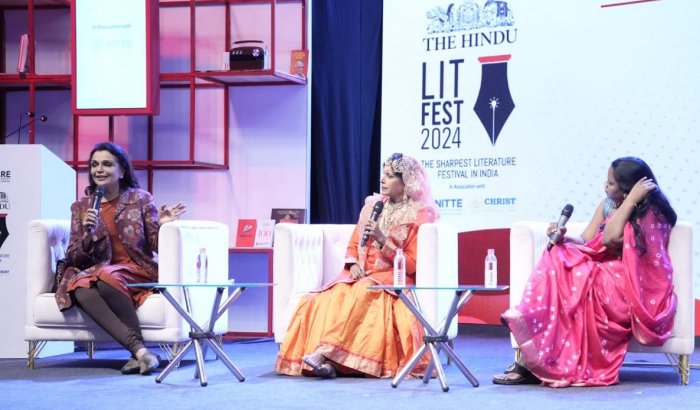 With Shovana Narayan & Shalin Maria Lawrence The HINDU newspaper sponsored LIT FEST concluded with record crowds in Chennai. The surging crowds included citizens and visitors across demographies and society. I look forward to this event annually, since it comes soon after the dance and music season. The exchange of ideas and opinions in politics, culture, food, fashion, cinema and subaltern theories is invigorating. While each session is under an hour and questions abound, it is the collision and cross illumination of these various elements that make Literature festivals so engaging. Personally, it has been an enriching encounter every year to be a part of this 2 day event. Moderating panels, meeting writers, performing in short theatrical presentations - they have all added to my experience and fuelled my curiosity about how minds work and what draws people to read, listen and learn. The session on women freedom fighters was especially important since it brought respected Dalit writer and intersectional feminist Shalin Maria Lawrence to the platform as the moderator to engage with the panelists. She emphasised that growling at one another across caste identities does little to foster dialogue - especially between women. We highlighted points of how modernity may have arrived in certain sections but do women have agency? How dialogue must be continuous and arguments should not disrupt the flow of ideas. The session was interspersed with two excerpts from a larger production WARRIOR WOMEN OF BHARAT, ideated by Prathibha Prahlad and produced by Prasiddha Foundation. Shovana Narayan shared her vision of Begum Hazrat Mahal of Awadh who kept the British at bay for 10 years. I returned to my cameo of Captain Lakshmi Sehgal of the Indian National Army under Netaji Bose. It was director Prasanna Ramaswamy who wanted to position these privileged historical figures against the personal struggles of millions of women. The INDIA ART FAIR in New Delhi is another fantastic event to attend. The profusion of colour and expressions is like a jolt of electricity for anyone looking to be inspired and mood elevated. There is much to explore and enjoy if only dancers put down that mirror and look around! #DECENTERING INDIA & HINDU CENTRISM With a provocative title, the AKADEMI-UK sponsored online webinar and 15 month dance project was launched. The organisers quickly established their credentials, acknowledged their privilege and proceeded to talk about expanding the dance studies and performance circle to include the dances of Bangladesh, Nepal, Himalayan borders, Afghanistan and Sri Lanka. To bring community, folk and ritual dance traditions to the attention of funders and dance enthusiasts was the focus. The extended project aims to cover dancers across identities, geographies and abilities. Deepening the connections between audiences in old age homes, hospitals, open spaces, young audiences and even nightclubs. The title was perhaps meant to raise a few hackles (it did!) and bring attention to the session. The main thrust was to pay attention to the lesser known and ignored forms of dance expressions that need support and development on the ground and within academia. With a finale scheduled for April 2025 at THE PLACE theatre in London, it will be interesting to see how far some of these localised performance styles can become more visible and broad based to newer audiences. #ONE EXTRA DAY FOR THE EXTRAORDINARY 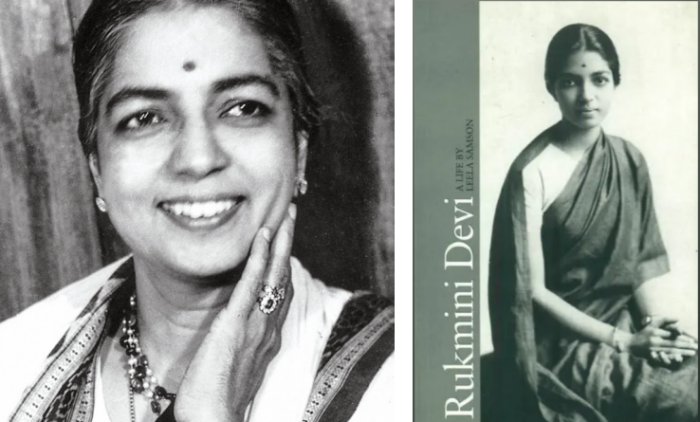 Rukmini Devi It's a leap year and we have an extra day in February. It's also the day - February 29 - that we can recognise a remarkable pioneer. Rukmini Devi Arundale - part of the WOMAN NATION/MOTHER INDIA project. DEVI was the word carefully chosen for this brilliant young woman but she was impatient at becoming a puppet of the very system of Theosophy that anointed her. On her 120th birth anniversary, we await a new biography written by V R Devika, a folklorist and currently on tour with her bestselling book on the female revolutionary Dr Muthulakshmi Reddy. Meanwhile, I urge readers interested in dance history to read Leela Samson's book on this iconic personality. Recuperating historical figures comes with its own set of challenges. In writing or speaking about Rukmini Devi Arundale (RDA), we must also ask ourselves who are not being represented? Her vision of Kalakshetra was supported and realised by a host of influences and individuals. That chance meeting with ballet superstar Anna Pavlova on a ship to Australia was a turning point in Rukmini Devi's career. Looking back at her achievements is humbling. What she achieved has been truly remarkable. If her beloved Kalakshetra is currently going through a churning, it is to be expected with every institution created by a single visionary. Each time a dancer ties that "practice sari", shortened to end at the knees- remember it is "Athai" who designed it. If the musical ensemble is seated stage right instead of following the performer, it was her decision. If women are conducting performances playing the nattuvangam, it is also thanks to RDA. While some dance historians (and some dancers) will continue to fling mud at this renaissance woman with words like "Sanskritisation", "sanitization", "cleansing", replacing "salamu" with the "namaskar" of the hereditary form, let us take this moment to acknowledge her remarkable contribution. Today, Kalakshetra graduates are in great demand as Bharatanatyam teachers in dance centres around the world. No other institution was founded on the bold ideals of braiding dance, music, education, weaving, craft and animal welfare. The morning multi faith prayer under the banyan tree continues to be an example of secularism. Let us applaud and be inspired by this brave and dynamic woman on her 120th birth anniversary, the first woman in Indian history to be nominated to the Rajya Sabha and who almost became the President of India! February 29 is also the birth date of former Indian Prime Minister Morarji Desai and dance scholar Ashish Khokar who is marking his father - dance historian and collector - Mohan Khokar's birth centenary throughout 2024. Watch out for monthly events that will bring focus to the world's largest private collection of dance memorabilia. Dancers visiting New Delhi should make a special effort to see the vast collection which is currently housed in the IGNCA building. The list of PADMA AWARDS contained many delights. Uppermost were the names of Padma Subrahmanyam and Vyjayanthimala Bali. To be conferred the Padma Vibhushan for their lifetime of concerted dedication to dance came with a whoop of joy to so many of their admirers. There were a total of 55 cultural figures on the PADMA list this year. I join with TEAM NARTHAKI in sending our congratulations and respects to all the winners. Thank you for your art and may generations be inspired by your determination and brilliance. Wishing all of you health, energy and hope! Wherever you are in the world - dance! However old or young you are - dance! However frail or robust you are - dance! Keep that rhythm - in your heart and in your step! Until next month and Spring time! Anita R Ratnam Chennai / USA anitaratnam.com Anita Says...by Dr. Anita R Ratnam APPLE PODCAST | SPOTIFY | YouTube Connect with us on Instagram and Facebook Response * Akka, this is an eclectic piece of writing! There is a little information I wanted to share though. While Rukmini Devi can certainly be credited with a lot of changes to the manner of presentation, the placement of accompanying orchestra to the right of the stage was a practice that was prevelant atleast a few hundred years prior her. The Sangita Saramrita of Tukkoji, discusses this in detail. The stages / performance spaces described in that text show that the audience had a unidirectional view of the artistes as the stages had a fixed backdrop. The shift of orchestra to both sides of the stage was both a necessity and a compulsion.... - mes rÍveries (Feb 7, 2024) Post your comments |